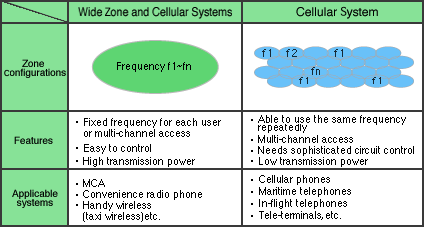Cellular Mobile Communication System -2.Technology
The cell configuration in mobile communications includes both large zone systems in which a single base station covers the entire service area, and cellular systems in which the service area is divided into several smaller areas, each of which has a base station. Although the large zone system can cover a larger service area as the radio waves can reach greater distances, the repeated use of frequencies is not possible except in more distant locations. Because the cellular system can repeatedly use limited frequency resources, it can cover a global-scale service area with only a small number of frequency bandwidths.
The basic consideration in cell configuration relates to the cell-shape repetition pattern. A method in which cells are combined in a pattern of hexagons has proved effective in both systems. More advanced and efficient configurations are being studied, such as the sector configuration in which each cell is further divided into fan-shaped sectors, the micro-cell configuration with a smaller radius, and the multiplex cell configuration in which different-sized cells are combined or overlapped in accordance with the characteristics of the service area.

Wide Zone and Cellular Systems
![]() Created 1999/03
Created 1999/03
